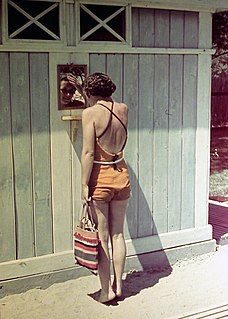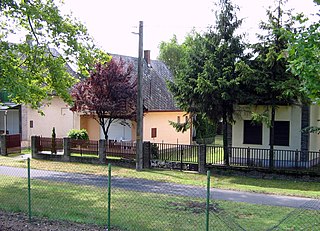
A spa town is a resort town based on a mineral spa. Patrons visit spas to "take the waters" for their purported health benefits. The word spa is derived from the name of Spa, a town in Belgium.

Hévíz Spa and the Szent András Hospital, Hévíz is a spa in Hungary. It is located in Hévíz, on the shores of the lake of the same name.

Komárom county was an administrative county (comitatus) of the Kingdom of Hungary, situated on both sides of the Danube river. Today, the territory to the north of the Danube is part of Slovakia, while the territory to the south of the Danube is part of Hungary.

Esztergom is a city in northern Hungary, 46 kilometres northwest of the capital Budapest. It lies in Komárom-Esztergom county, on the right bank of the river Danube, which forms the border with Slovakia there. Esztergom was the capital of Hungary from the 10th till the mid-13th century when King Béla IV of Hungary moved the royal seat to Buda.

A spa is a location where mineral-rich spring water is used to give medicinal baths. Spa towns or spa resorts typically offer various health treatments, which are also known as balneotherapy. The belief in the curative powers of mineral waters goes back to prehistoric times. Such practices have been popular worldwide, but are especially widespread in Europe and Japan. Day spas are also quite popular and offer various personal care treatments.

Hévíz–Balaton Airport, previously also known as Sármellék International Airport, is an international airport in Hungary located west of Lake Balaton, 1 kilometre (0.6 mi) south-southwest of the village of Sármellék, Zala County and Keszthely. It gains importance due to the proximity of Lake Balaton, Hungary's most important holiday resort and the thermal spas of Hévíz and Zalakaros.

The Széchenyi Medicinal Bath in Budapest is the largest medicinal bath in Europe. Its water is supplied by two thermal springs, their temperature is 74 °C (165 °F) and 77 °C (171 °F).
Hajdúszoboszló is a town in Hajdú-Bihar county, Hungary, 19 kilometres southwest of county seat Debrecen. It is the third largest town in Hajdú-Bihar county.

Hévíz is a spa town in Zala County, Hungary, about 8 kilometres from Keszthely.

Balatonberény is a village in Somogy county, Hungary, with a popular nudist beach. The country village had a population of 1,200 in 2011.

There is a long history of tourism in Hungary, and Hungary was the world's thirteenth most visited tourist destination country in 2002. Tourism increased by nearly 7 percent between 2004 and 2005. European visitors comprise more than 98 per cent of Hungary's tourists. Austria, Germany, and Slovakia make the largest numbers of visitors to the country. Most tourists arrive by car and stay for a short period of time. Hungary's tourist season is from April through October. July and August are the best tourist months. Budapest is the country's most popular tourist destination.

This article discusses the administrative divisions of the Kingdom of Hungary between 1941 and 1945. As a result of the First (1938) and Second Vienna Award (1940), territories that had been ceded by the Kingdom of Hungary at the 1920 Treaty of Trianon were partly regained from Czechoslovakia and Romania respectively. This required modification of the administrative divisions.
Thermal baths or spas in Budapest are popular tourist attractions as well as public comforts for the city's residents.
The Saint Margaret of Scotland Anglican Episcopal Church is an Anglican congregation in Budapest, Hungary. The church belongs to the Church of England, part of the Diocese in Europe.

The Friedrichsbad is a spa in the city of Baden-Baden in Germany. The Neo-renaissance spa building was completed in 1877.
This page is based on this
Wikipedia article Text is available under the
CC BY-SA 4.0 license; additional terms may apply.
Images, videos and audio are available under their respective licenses.


















